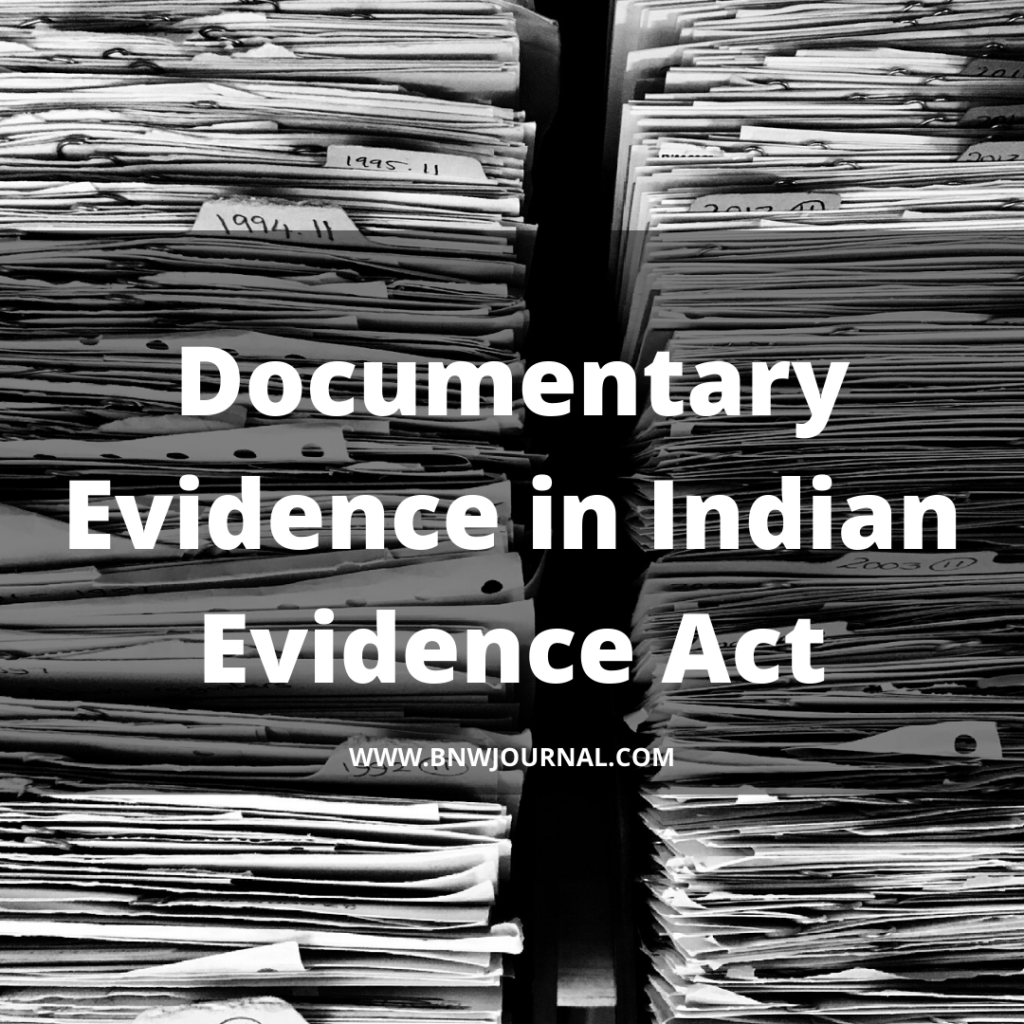![]()
INTRODUCTION
Evidence is something that ascertains the existence or nonexistence of a certain fact. It is derived from the Latin word “evidential” which means obvious or make things clear. It is used by the party who alleges to prove the existence of fact while the opposite party uses to deny its existence in other words “evidence is the means of satisfying the court of the truth or untruth of disputed fact between the parties in their pleadings”.[1] Evidence is an essential part of the court making a decision, Without evidence, there can be no proof. Evidence provides information to the court. Proving facts by presenting evidence helps in convincing the court to accept a clear account of events.

DOCUMENTARY EVIDENCE
Documentary evidence documents that are produce before the court for inspection. Document ” means any matter expressed or described upon any substance by means of letters, figures. or marks, or by more than one of these means, intended to be used, or which may be used, for the purpose of recording that matter”.[2]Where there is documentary evidence, oral evidence is not entitle to any weight.[3] Documentary evidence is divided into two types primary documentary evidence and secondary documentary evidence.
One of the essential element is that it should be sign by the party or parties associate with it. Where there is no such signature and the document stand completely detach from and unconnect with any person or party, there can be no question of the same being use by anybody against another.[4] Document should be prove to be executed and documents mark as proof without cannot form the basis of judgment.[5] Where there is documentary evidence and the oral testimony is full of conflict, documentary evidence is always preferred.[6]
It has been normally follow that the word “document” in Evidence Law should not be use narrowly. By Etymological meaning it is something that shows evidential or informative character. It was held in a case where the terms of compromise were recorded and signed by the court was considered as a document.[7]
Documentary evidence is not limited to documents that can be sensed through ocular inspection but also other senses. In Grant v Southwestern Properties[8], it was held that tape recording was a document. Though it did not provide information for the eye but only for the ear it is still a document liable for inspection. The document is not limited to ocular inspection but included scrutiny or examination by any senses. N.Sri Rama Reddy v. V.V. Giri[9] The Supreme Court held that dialogue recorded in tape record is a documentary evidence.
The value of evidence depends on its admissibility, relevance, weight, and sufficiency. This itself is the major reason of classification of the documentary evidence into primary evidence and secondary evidence Unlawfully procure document is no obstacle to its admissibility as long as it is important, and its genuineness is prove. Genuine depends on the circumstances.[10] According to the rules of Evidence act every content of the written paper should be proved by the original document.
Section 61 says that the contents of a document may be proved either by the production of the original document, which is called primary evidence, or in certain cases by oral account of its contents.[11]”May” in this section does not mean it is alternative or optional. where there is an original document in existence and is available its contents must be proved by primary evidence.[12]
PRINCIPLE
The first permanent record of a transaction is the original document. It is the most accurate of first-hand evidence and many times records are change. It is hence important to have the original to test if changes are part of the document or are subsequently made.[13] All that doesn’t qualify this degree falls under the category of secondary evidence. It is not just about quality but also about the strength of proof. It is a distinction of law and not fact.
“An original document is the first permanent record of a transaction. It is first-hand evidence and presumptively the most reliable. Besides, documents are often interlined or altered. Therefore, it is desirable to have the original to see if alterations are part of the document or are made subsequently”.[14]
Section 64 states that Documents must be proved by primary evidence except under certain conditions. This is based on the cardinal rule that the best evidence should be brought before the court.[15] In Ramlakshmi v Sivanatha, when dealing with documentary evidence substantial principle on which authenticity and value of evidence rest ought to be observed. Secondary evidence is not at all acceptable unless there is a reason for not bringing the primary document.
In Ramprasad v. Raghunandad Prasad[16], the court explained “In India, the rule is the same as in England. The section means that there no other method allowed by law for providing the contents of a document except by the primary or the secondary evidence”. “Where admissions were made in a written statement by the plaintiff’s predecessors-in-interest which was file in several judicial proceedings regarding the rights in the suit property, a certify copy of the written statement was held to be admissible in proof of the settled rights to the property”.[17]
In the case of newspaper all copies of the newspaper on the same date are considered original and not as secondary evidence.
References:
[1] https://www.abyssinialaw.com/about-us/item/932-meaning-and-nature-of-evidence-law
[2] Section 3 of Indian Evidence Act,1872
[3] Bhimappa v Allisab, AIR 2006 Kant 231
[4] R&D Law of Evidence, 23rd Edition, Lexis Nexis, pg.46
[5] A. Munuswami v R. Sethuraman, AIR 1995 Mad 375
[6] Siddapuram Siva Reddy v. State of A.P. 1995 CrLJ 701
[7] Raksh Rai v. Ram Lal A.I.R 1987 P.& H. 60
[8] 1974 2 All ER 465
[9] (1970) 2 S.C.C. 340
[10] Magraj Patodia v R.K.Birla, AIR 1971 SC 1295
[11] Bhimappa v Allisab, AIR 2006 Kant 231
[12] Sarkar Law of Evidence, Vol.1, LexisNexis Pg.1434
[13] Sarkar Law of Evidence, Vol.1, LexisNexis, 1435
[14] Oral & Documentary Evidence
[15] In re: Vadlamudi Kutumba Rao, AIR 1957 AP 595
[16] Ramprasad v. Raghunandad Prasad, (1885) 7 ALL 138 (143).
[17] Raman Pillai v. Kumaran Parameswaram A.I.R. 2002 Ker. 133



0 Comments